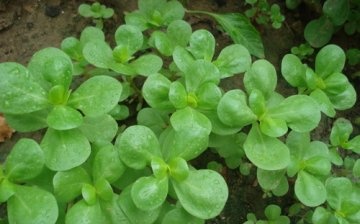Vegetable purslane - good for health
Among gardeners, purslane is a rather popular and well-known plant. But gardeners undeservedly bypass it, although purslane has been known as a vegetable plant for a very long time.
Vegetable purslane is an annual plant. Its stems are juicy, fleshy, reaching a height of 60 cm. The leaves also match the stems: fleshy, medium-sized, yellowish or light green in color. Purslane blooms with yellow flowers located in the axils of the leaves and in the branches of the stems. Flowering begins in June and lasts until September.
In one season, the greens from the purslane are cut off almost completely 2-3 times. Moreover, the first cut can be carried out only 20-30 days after planting. The leaves of the vegetable purslane are used for food, the tops of the stems, if desired, you can eat and flowers.
Fresh vegetable purslane is used as greens, for making salads, it is added to green soups, and sauces are made on its basis. It is also well marinated: in this form, vegetable purslane is very tasty as an appetizer served with meat dishes.
Young juicy leaves and stems of purslane are rich in minerals, vitamins (especially vitamin C), and easily digestible proteins. For a long time, purslane was considered a medicinal plant. Its properties were appreciated in the treatment of liver and kidney diseases, diabetes mellitus. In folk medicine, purslane leaves were used to accelerate wound healing.
The advantages of this plant include unpretentiousness. The only thing that purslane needs for successful growth is fertile soil.



